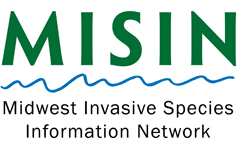|
Giant knotweed
Introduced to North America from Japan in the late 1800's as an ornamental garden plant.
Why is it a problem? Like other invasive plants in the top 20 for northwest Michigan, giant knotweed out-competes native plants and provides little food or other habitat for wildlife. Giant knotweed is problematic for infrastructure as well, as it can sprout up through concrete and asphalt, spread quickly, and is difficult to eradicate. In Great Britain, knotweed infestations drastically lower property values and may even prevent sale or insurance. For these reasons, giant knotweed is one of the few prohibited plant species in Michigan. Although illegal to buy, sell, plant, or otherwise spread giant knotweed, occasionally it is still sold under other names, like “Michigan bamboo” and “pink fleece flower.” Giant knotweed is very hardy and can tolerate ash, sulfur, and toxic gases in its native range. In addition, giant knotweed can tolerate high salinity, full shade, high temperatures, and drought. What does giant knotweed look like? Giant knotweed is a perennial plant that can grow up to 12 feet high. The leaves have a shallow, heart-shaped base. They are alternate, and can reach 6-12 inches long and two thirds as wide. In the late summer the spiky sprays of green-white may be confused with pokeweed, but lacks the black berries of the native plant. In winter, knotweed is easy to identify by its persisting hollow red-brown stalks. How do I manage giant knotweed? Avoid planting or spreading giant knotweed (it’s illegal!), monitor natural areas for signs of knotweed, and report any plants found as soon as possible. Giant knotweed is extremely difficult to treat; its deep root system and fragmenting abilities (it is able to sprout into a new plant from a small piece broken off the plant) make it nearly impossible to dig out; and many herbicides have proven ineffective. Consult with a professional to control this invader. |
|
| habitatmatters.org |
Contact US231-252-4148
3334 Veterans Drive Unit A Traverse City, Michigan 49685 |
Pleasant Peninsula Design, Habitat Matters 2017




